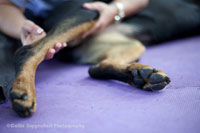CARE’s veterinarians and physical therapists, all certified in canine rehabilitation, create and customize a comprehensive home exercise program for each pet. The home exercise plan is a very important part of success and it is tailored specifically for your pet’s needs and goals. The plan will change as your pet progresses and will be continuously updated by your CARE doctor and posted to our exclusive website – Flexible Pet – which you can conveniently access from home.
We will teach you how to best perform each exercise, so that you can help to eliminate your pet’s pain and help your pet become more mobile at home.










